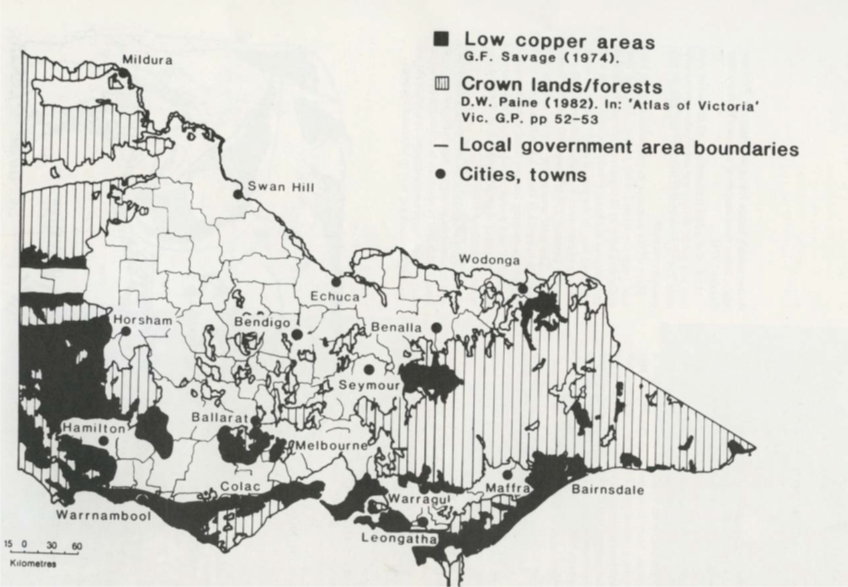Copper deficiency
John Jardine, Veterinary Officer, Agriculture Victoria
Copper deficiency was a significant problem encountered by sheep producers in west and south-west Victoria during spring and early summer last year. It presented as fractured legs and enzootic ataxia (swayback) in weaned and unweaned lambs.
Copper deficiency has been described in sheep in Victoria since 1945 and several parts of the state have been diagnosed with copper deficiency in pasture or livestock, see Figure 7. Areas of peat swamp, granite soil, or sandy soil near the coast can be naturally lacking in copper.

Copper is an essential trace element, being involved in at least 10 enzymes which catalyse oxidase type reactions in animals. Copper is required for body, bone and wool growth, for pigmentation, myelination of nerve fibres and leucocyte function (Underwood 1977, Arthur et al. 1981).
Copper concentration in a pasture is affected by the pasture species, maturity of the grass and the season. Grasses generally have lower copper concentrations than clovers.
The copper concentration declines in pasture from winter to late spring. During summer, as the grasses dry off, the concentration increases and the copper forms in the pasture change to make it more readily absorbed by animals. During this time the rumen flora change to a more fibrous diet and this further aids copper absorption.
Clinical signs associated with copper deficiency
- Wool abnormalities, loss of wool crimp is one of the first clinical signs of copper deficiency in sheep. The wool develops a sheen or lustre (‘steely wool’) with crimps 3 to 4 times normal width, and it has greatly reduced tensile strength and elasticity. Greying of black-woolled sheep is a sensitive sign of copper deficiency
- Enzootic ataxia (swayback), The nervous tissue of the lamb has a special requirement for copper in the last two months of gestation, when it is rapidly developing, and in the immediate post-natal period. The ataxia is seen as paralysis or a staggering gait in newborn lambs or develops up to 6 weeks after birth
- Bone fragility in lambs is often associated with copper deficiency, with increased incidence of fractures in long bones and rib bones
- Anaemia in sheep can occur with extreme copper deficiency. In grazing sheep, parasitism, cobalt deficiency or malnutrition are more likely to be causes of anaemia than copper deficiency alone.
Interactions with other minerals
High dietary intakes of molybdenum, sulphur, zinc, iron, cadmium and calcium have all been shown to decrease the availability of dietary copper to animals (ARC 1980, Underwood 1977).
In the Victorian situation, the interaction between copper and molybdenum is particularly important in determining copper availability to animals. Many of the areas that are marginal or deficient in copper are also deficient in molybdenum (Savage 1974) and molybdenum applications to these areas can exacerbate the copper deficiency.
Liming of pastures can result in an overall decrease in copper available to animals and can increase the availability of molybdenum.
Diagnosing copper deficiency
Diagnosis of copper deficiency is made by testing a blood or liver sample. This is best performed during at risk periods (winter and spring). Further testing of pastures may be useful if the sulphur and molybdenum concentrations are measured as well to see if there are interactions with other minerals.
Treatment options
In the short term an injection, a rumen bullet or a feed supplement that contains copper can be given to affected animals. In the longer term, long-acting injections or rumen bullets can be included as part of the flock’s management plan.
Other options include topdressing paddocks with copper or using a fertiliser with added copper. Please discuss this with your fertiliser consultant/retailer for advice.
Copper toxicity
Care needs to be taken when supplementing with copper. Sheep are prone to acute and chronic copper toxicity. It is not advisable to give large amounts of copper to animals when their copper status is unknown and if giving copper in several ways, such as in feed and an injection.